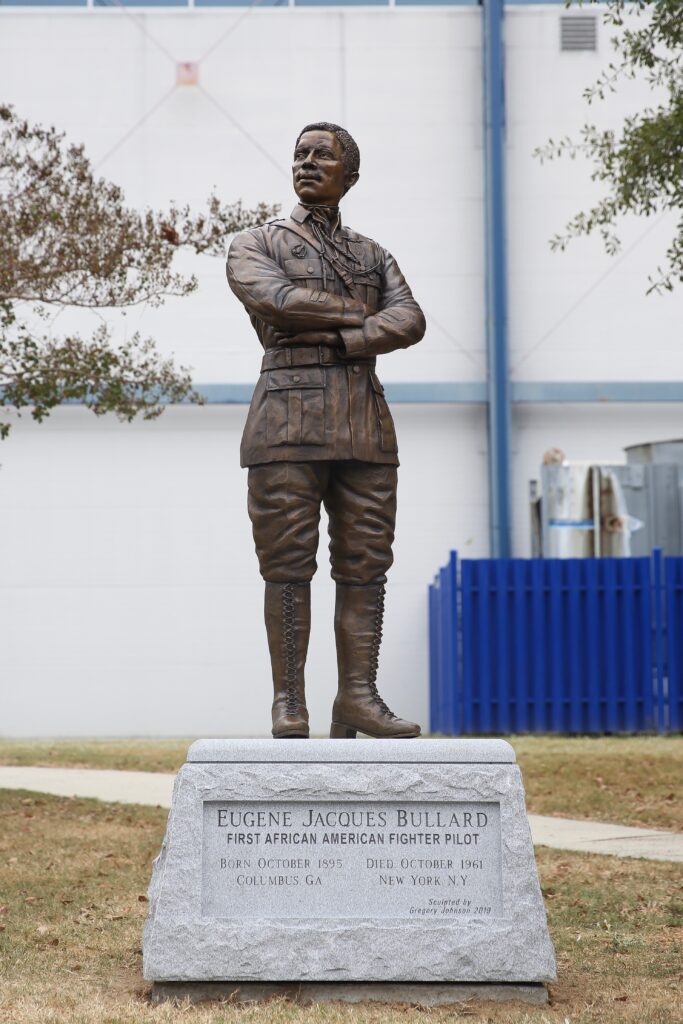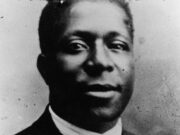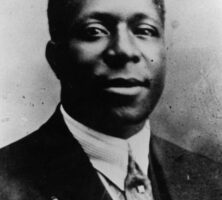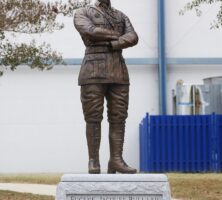Eugene Bullard was the world’s first Black combat aviator, flying in French squadrons during World War I (1917-18). Before he became a pilot he served in the French infantry and was awarded the Croix de Guerre.
Born in a three-room house in Columbus, Eugene James (Jacques) Bullard was the seventh child of Josephine Thomas and William O. Bullard. Bullard’s parents, married in Stewart County in 1882, had Creek Indian as well as African American ancestry. William Bullard was born enslaved on the property of Wiley Bullard, a planter in Stewart County. In the early 1890s William Bullard moved to Columbus, where he worked for W. C. Bradley, a rising cotton merchant.
The young Bullard attended the Twenty-eighth Street School from 1901 to 1906. Although his education was minimal, he nonetheless learned to read, one of the keys to his later successes. With his older sister and brothers, Bullard absorbed his father’s conviction that African Americans must maintain dignity and self-respect in the face of the prejudice of a white majority determined to “keep blacks in their place” at the bottom of society. Shaken by the near lynching of his father in 1903 and seeking adventure in the world beyond Columbus, he ran away from home in 1906.
In Atlanta he joined a group of Roma (an English clan known by the surname Stanley) and traveled with them throughout rural Georgia, tending and learning to race their horses. The Stanleys brought to his attention that the racial color line did not exist in England. Disheartened that the Roma were not soon returning home, Bullard left them at their camp in Bronwood in 1909 and found work and patronage with the Zachariah Turner family of Dawson. Friendly and hard working as a stable boy, Bullard won the affection of the Turners, who allowed him to ride as their jockey in horse races at the Terrell County Fair in 1911.
Despite his relationship with the Turners, Bullard was still affronted by racism and he resolved to leave the United States for Great Britain. He did so as a stowaway on a German merchant ship, the Marta Russ, which departed Norfolk, Virginia, on March 4, 1912, bound for Aberdeen, Scotland. In 1912-14, Bullard performed in a vaudeville troupe and earned money as a prizefighter in Great Britain and elsewhere in Western Europe. He appeared in Paris for the first time at a boxing match in November 1913.

At the beginning of World War I, Bullard joined the French army, serving in the Moroccan Division of the 170th Infantry Regiment. The French government awarded him the Croix de Guerre for his bravery at the Battle of Verdun. Twice wounded and declared unfit for infantry service, he requested assignment to flight training. He amassed a distinguished record in the air, flying twenty missions and downing at least one German plane.
Between the world wars he owned and managed nightclubs in the Montmartre section of Paris, where he emerged as a leading personality among such African American entertainers as Josephine Baker, Louis Armstrong, and Sidney Bechet. In 1923 he married Marcelle Straumann, the daughter of a wealthy Parisian family. The couple had two surviving children, Jacqueline and Lolita, before separating in 1931. In the late 1930s Bullard joined a French government counterintelligence network spying on Germans in Paris. When Nazi Germany conquered France in 1940 Bullard and his daughters escaped to New York City. He worked there in a variety of occupations for the rest of his life.
In 1959 French president Charles de Gaulle made Bullard a knight of the French Legion of Honor, the nation’s highest ranking order and decoration. Bullard died on October 12, 1961.










